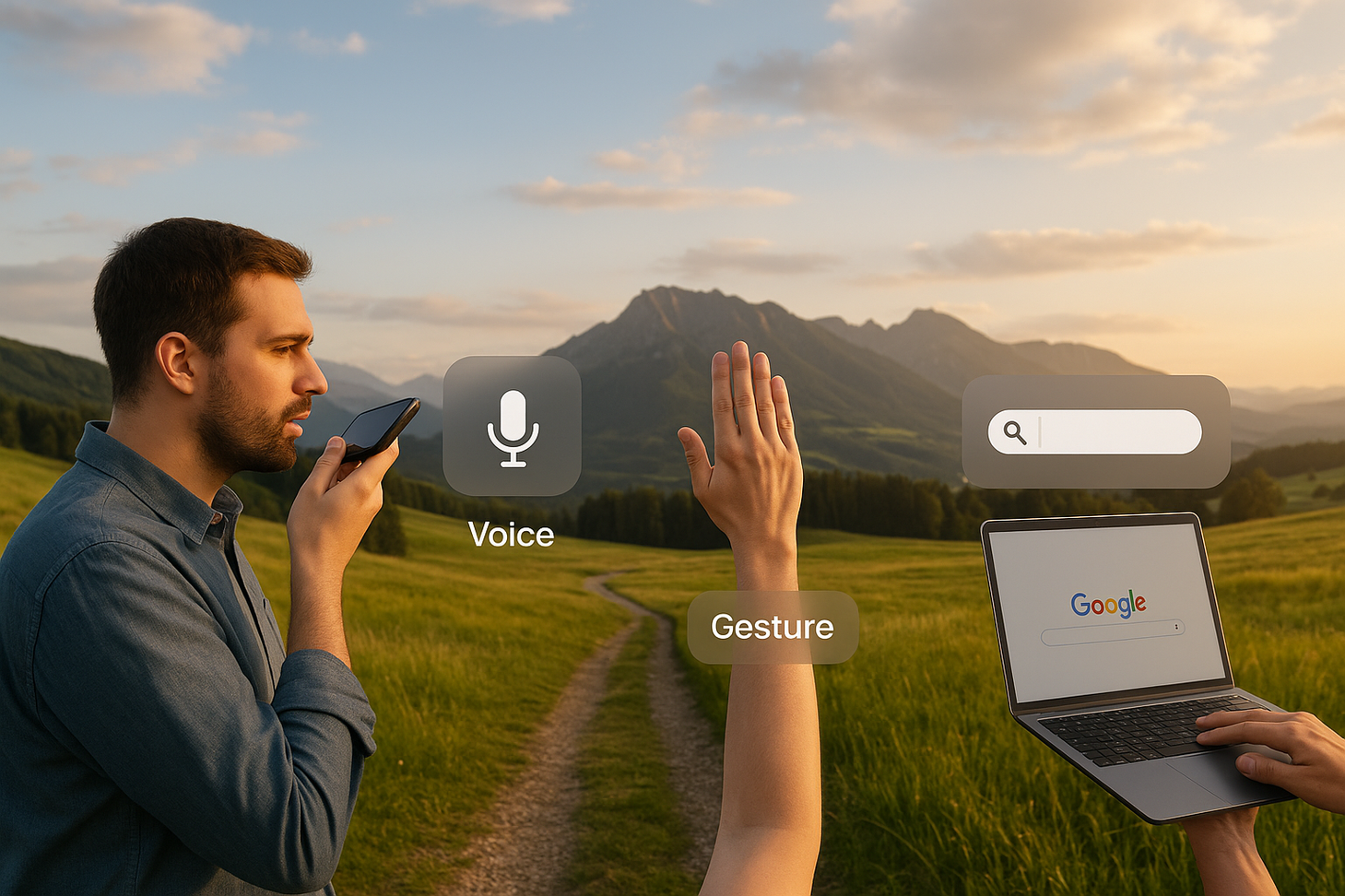The Search Revolution is Here
Have you ever stopped and thought about how weird it is that we used to only search stuff by typing? Actually sitting down, opening Google, and punching in exact keywords like “best pizza near me.” That world’s gone. These days, people just blurt out whatever they want to their phones, swipe through visuals, or even draw on their screens to find what they need. It’s not some futuristic tech demo; it’s happening every day, all around us. And if you’re still treating SEO like it’s 2010, you’re basically invisible. This whole shift is what marketers now call Multimodal SEO. It sounds fancy, but it really just means we’re no longer dealing with just typed-out search terms.
We’ve got voice search, gesture search (yes, drawing things), image search, and, yes, text is still there, but it’s just one part of the mix. I’ve been working with brands long enough to see who adapts and who gets left behind. The ones still clinging to keyword stuffing and blog spam? Brutal. The ones leaning into this new behaviour? They’re killing it. Stats? Sure, there are plenty. Voice queries are blowing up. Tools like Google Lens are changing how people shop and explore. But honestly, you don’t need a chart to feel it. Just watch someone order groceries by talking to Alexa or search for a sofa by snapping a pic on Pinterest. It’s all around. And that’s the point: if you’re not optimising for how people actually search today, you’re already late to the game. So here’s what I’m gonna do: break down five solid, no-BS strategies that’ll help you show up no matter how someone’s searching, talking, typing, snapping, whatever. Whether you’re deep into SEO or just winging it so far, this is the kind of stuff that gets results now. Let’s get into it.
Understanding the Multimodal Search Landscape
SEO ain’t what it used to be. Back in the day, you’d slap a few keywords into a blog post, throw in some H1s and meta tags, and that was your job done. It wasn’t rocket science. Now? People don’t just type stuff into search bars anymore. They talk to their phones. They take pictures of stuff they want answers about. Some even draw gestures on screens like we’re all in a sci-fi movie. And wildest part? It works. Like, it actually gives them results. That’s the new reality. And this isn’t just some trend that’ll fade out in six months. This is how people naturally search now. Think about it, when you’re cooking and your hands are all messy, are you typing “how long to bake salmon” into your phone? Nope. You’re yelling, “Hey Google, how long does salmon go in the oven?” That’s voice search. Or say you see someone on the street wearing a killer jacket—you don’t describe it in words, you just snap a pic and reverse search it. Visual search. It’s not tech anymore; it’s normal.
Behind all this? Big, scary, smart AI. Not the Terminator kind, but the kind that actually gets what you’re trying to say (or show). Google doesn’t just look at words on a page. It figures out what you mean, how you’re saying it, what you’re looking at, and even how you move on your screen. Creepy? Kinda. Useful? Absolutely. And this is happening right now. Not next year. Not someday. People talk to Siri as if it were their roommate. Kids are using Google Lens to do their homework (not even kidding). And touch gestures? They’re everywhere now, double tap, swipe up, pinch to zoom. It’s not even fancy anymore; it’s just how people interact. You can either build your content around how real humans are searching or be that outdated site that no one ever finds. Here’s what’s nuts: people aren’t even sticking to one method. They’ll start with voice: “Show me black sneakers under $100.” Then they’ll use visual filters, maybe swipe around, zoom into images. It’s all one weird, blended search experience. And if you’re still optimising just for typed-out keywords? You’re missing the whole picture. Like, not even showing up in the game.
5 Ultimate Strategies to Master Multimodal Search
1. Master Conversational Content Optimisation
Voice Search Is a Whole New Ballgame
People talk to their phones like they’re talking to a friend. They’re not typing clunky keyword phrases like “best Italian restaurant in Chicago.” They’re saying stuff like, “Hey, where’s a good Italian spot near downtown that’s open right now?” It’s more casual, more specific, and way more human. Voice search isn’t about cramming in keywords. It’s about understanding how people actually speak. If your content still reads like it was written for a machine instead of a person, good luck ranking in voice results. You’ve gotta sound like someone talking in the real world, not like someone trying to game the algorithm.
What You Should Actually Be Doing (Like, Right Now)
- Ditch the robotic keyword phrases. Nobody says “weather forecast New York June” out loud. Start thinking in full, conversational questions.
- Use tools that surface natural language queries. Look for searches that start with “what,” “how,” “why,” “when,” and “where.” That’s the meat of how people talk to search assistants.
- Write like you talk. If you wouldn’t say it to a friend in conversation, don’t write it in your content. Seriously. Read it out loud and ask yourself if it sounds normal.
- Front-load clear answers. Try to hit that sweet spot of around 29 words or less; that’s what most voice assistants are pulling for responses. Get to the point, fast.
- Then go deeper. Once you give the quick hit, expand with examples, context, and even stories. Think: “Quick answer first, now let me explain why.”
Want to Go Next-Level? Build Around Themes, Not Keywords
Okay, here’s the smarter play. Stop building one boring page per keyword. That’s old-school SEO thinking, and it doesn’t hold up in a multimodal world. Instead:
- Think in clusters. Let’s say your audience is into home-brewed coffee. Don’t write three different posts like “How to Brew Coffee,” “Types of Coffee Beans,” and “Best Coffee Equipment.”
- Bundle it all into one mega-helpful guide that answers everything someone might ask when they want to up their coffee game.
- Answer every question you can imagine a beginner asking. Not in jargon. In real, normal-person language.
This kind of content doesn’t just rank better; it feels better. It respects how real humans think, search, and learn.
Final Thought
People don’t speak in bullet points. They ramble. They ask weirdly specific stuff. They want fast answers, but they also want someone who gets them. Your job is to be that voice, clear, helpful, and above all, human. That’s the heart of voice search SEO.
2. Dominate Featured Snippets for Voice Visibility
Snippets = Voice Gold
Here’s something nobody really tells you upfront: when smart assistants like Google Assistant or Alexa give answers out loud, they’re not digging deep into search results. They’re grabbing what’s already sitting in those featured snippets; yep, that little “position zero” box at the top of the page. So, if your content’s not there, you’re basically muted in voice search. And in a world where more and more people are asking their phones questions instead of typing them, that’s a brutal place to be. It’s not just about clicks anymore. If you land that snippet, you don’t just appear in search; you become the answer. That’s power.
How to Actually Get That Spot (And Not Just Hope for It)
- Start with some old-school recon. Google your niche questions and actually look at who’s already landing those featured snippets. What do they have in common? Are they using lists? Tables? Short, punchy definitions?
- Mimic what works—but do it better. Don’t copy, but notice the structure. Are the answers short and snappy? Are they following a format? Cool. Now build yours with that in mind, but cleaner, sharper, and with more actual helpfulness.
- Use clear, logical headers. Think H2s and H3s that actually ask the question a user would speak aloud. Like: “What is Multimodal SEO?” or “How does voice search work?”
- Answer immediately. Don’t fluff. Right after the heading, drop the answer: no long-winded intros, no fluff. Get to the point immediately. That’s the part Google might read out loud.
- Then go deeper. Once you’ve served the bite-sized answer, you can expand, explain, and guide the reader down the rabbit hole. But that first 30-ish words? That’s the money line.
Pro Tip: Speak Google’s Language With FAQ Schema
This is one of those behind-the-scenes moves that actually makes a difference.
- Add the FAQ schema to your content. Seriously. It’s not that hard, and it helps Google understand your page isn’t just a wall of text—it’s structured Q&A.
- Mark up actual user questions. Stuff like: “Can I optimise for voice search without coding?” or “What’s the best way to show up in featured snippets?”
- This makes you way more likely to show up in rich results, especially for voice queries, which love clean, structured content.
Final Thought
Everyone’s chasing page one. But with voice, page one isn’t enough anymore. If you’re not sitting right up top in that snippet box, you’re invisible. Featured snippets aren’t just nice to have; they’re how you get heard when people aren’t even looking at their screens.
3. Optimise for Visual and Gesture Search Integration
Visual + Gesture Search Isn’t Sci-Fi Anymore
“Google Gesture Search” still sounds like something from a nerdy tech conference, right? But here’s the catch: it’s very real, and it’s coming for mobile-first audiences fast. We’re heading toward a world where people don’t just search by typing or even speaking; they’re swiping, pinching, circling stuff on their screens to find answers. Sounds wild, but it’s already here in bits and pieces. If you’re waiting till this stuff goes mainstream before you optimise for it, you’ll already be behind. Visual search? That’s already happening. People are using tools like Google Lens to ID plants, shoes, furniture, basically everything. They’re not asking questions, they’re pointing cameras. If your content isn’t ready for that shift, you’re invisible.
Visual Search Optimisation: Make Your Content Searchable by Sight
This is where most brands get it wrong. They post blurry product photos and think that’s enough. It’s not. If your image sucks, you don’t even get on the radar.
- Use sharp, high-res images. No one wants to zoom in on pixelated junk. If the photo looks like it was taken on a flip phone, don’t even upload it.
- Light it properly. Natural light > flash. Every time.
- Give your images proper filenames. Not “IMG_0383929.jpg.” Try “black-running-shoes-men-nike.jpg.” You know, so Google knows what it is.
- Alt text is your secret weapon. Don’t cram it with keywords. Just describe what’s actually in the photo, like you’re explaining it to someone who can’t see.
- Think visually. Add step-by-step photo tutorials, before-and-after shots, comparison images, or use-case demos. If someone’s searching by image, they’re trying to see something. So show it.
Gesture-Friendly Design: Build for Hands, Not Just Eyes
Most mobile experiences are clunky. Buttons are too small. Galleries are awkward. People don’t tap; they swipe, drag, hold, flick. You’ve got to design for that.
- Think swipe-first. Use swipeable galleries, carousels, horizontal scrolls—especially for product or service displays.
- Keep touch zones big enough. Nobody wants to fat-finger their way through a broken UI.
- Anticipate motion. If your content is buried behind three weird taps and a scroll, forget it. Make the important stuff show up with one clean gesture.
- Even better—look ahead. Ask yourself: how would someone draw or circle something to search for this? That’s where gesture search is heading. You don’t need to go full Minority Report, but laying the groundwork now means you’re ready when that future becomes now.
Final Thought
Although it still feels a little “next-gen,” visual and gesture-based search is becoming more and more ingrained in daily life. People already Google things they can’t describe with their camera. And motions? Whether users are aware of it or not, every contemporary software is teaching them to interact in that manner. The goal of optimising now is to get in before your rivals do, not to follow a trend.
4. Create Integrated Content Experiences
Multimodal = One Experience, Not 3 Separate Projects
Here’s where a lot of brands screw up—they treat text search, voice search, and visual search like totally different departments. So their voice stuff feels robotic, their blog reads like an SEO textbook, and their visuals? Basically, a stock image filler. But people don’t experience content in silos. One minute, they’re talking to their smart speaker, the next they’re skimming a blog post, and then they’re zooming in on a product pic from that same post. It’s all one journey. And if your content doesn’t feel cohesive across the board, you’re dropping the ball.
Content Integration Framework: Blend Media Like a Pro
You want to create content that doesn’t just exist in multiple formats—it works together. Like a real system, not random parts duct-taped into place.
- Mix your media. A good guide doesn’t just have words. Think: written walk-throughs, audio clips for voice interaction, diagrams or visuals that explain the hard parts, and maybe a swipeable element if it’s mobile.
- Match the message across formats. Your blog can’t say one thing while your voice assistant says another. Make sure the tone, the info, and the purpose match, even if the format is different.
- Think accessibility meets SEO. Your text? Optimised for Google’s crawler. Your audio? Conversational and natural. Your images? Tagged properly, clean, and useful. Each piece should pull its own weight while still playing nice with the others.
Cross-Modal Discovery: Meet Users Wherever They Are
People bounce between formats all the time. They might start with voice—“Hey Google, how do I start a podcast?”—but end up reading a detailed blog post on your site 30 seconds later. That jump should feel seamless, not like they’ve landed on a totally different planet.
- Design for the switch. Voice answer → link to blog. Image search → swipe through visual examples → then guide them to the written deep dive.
- Make every entry point feel like a front door. Whether they arrive through voice, visual, or text, your content should welcome them in with context and clarity.
- Give options. Some folks want to listen to tips. Others want to read it. A few will only look at pictures and scroll through them. If you’re only creating one format, you’re leaving traffic on the table.
Final Thought
Multimodal SEO isn’t about stuffing your strategy into a hundred boxes—it’s about building a single, smart, user-first experience that just happens to show up everywhere. Treat it like one living, breathing ecosystem, not a checklist. People won’t remember how they found you. But they will remember if your content worked once they did.
5. Implement Advanced Technical Optimisation
5. Multimodal SEO Needs Smarter Tech, Not Just More Keywords
Technical SEO for multimodal search isn’t your average title-tag, meta-description, “fix a 404 and call it a day” kind of job. If you want your content to show up in voice, visual, text, and gesture-based results, your backend needs to be airtight. That means structure, speed, accessibility, and making sure search engines understand exactly what your content is and who it’s for. The scary part? Most people don’t even realise they’re invisible in multimodal search. You can have the best blog in the world, but if Google can’t parse your schema or your mobile page takes too long to load, it’s game over.
Schema Markup Strategy: Speak Fluent Google
This is your chance to tell search engines what your content really means, not just what it says. Schema is how you do that. And yes, it’s not sexy, but it’s crucial.
- Use JSON-LD. It’s what Google likes. It’s cleaner, easier to maintain, and doesn’t make your site look like it was coded in 1998.
- Add FAQ schema for voice search. Want Google Assistant to read your answers out loud? You need this. Period.
- Add image schema for visual content. This helps your product photos, tutorials, and infographics show up in image-based results.
- Add video schema if you’ve got multimedia. If you’re putting in the effort to create videos, don’t skip this step. It helps your stuff surface in video carousels and voice snippets, too.
- Go beyond keywords—think entities. Instead of just repeating phrases like “digital marketing tips,” focus on building real topic relevance. Connect your content to known topics, brands, people, and places. That’s how Google starts seeing you as a legit authority, not just another blog post.
Performance Optimisation: Speed and UX Are Non-Negotiable Now
People don’t wait. Especially on mobile. Especially when they’re doing voice or gesture searches. If your page loads slowly, they bounce. Simple as that.
- Compress your images. High quality doesn’t mean massive file sizes. Use modern formats (such as WebP) and test your load times. If it takes more than 2–3 seconds? Too slow.
- Use lazy loading, especially for image-heavy pages. Load what’s visible first, and delay the rest. It’s not cheating—it’s smart.
- Make it mobile-first, not mobile-also. The majority of gesture, visual, and voice search happens on mobile. So your design needs to start there. Not just shrink the desktop version.
- Design for every input. Some people will tap. Others will talk. Some might swipe. Your content should be accessible, usable, and clean across all of that. Think less “desktop layout,” more “what happens if someone talks to this page?”
Final Thought
Advanced technical SEO isn’t glamorous. It’s not going to go viral on LinkedIn. But it’s the foundation that makes everything else work. A schema tells Google what your content is about. Fast load times keep users on the page. Mobile-first design makes your stuff actually usable in the real world. Without this layer, even your best content might as well be sitting on a floppy disk.
Advanced Implementation Techniques
Local Multimodal SEO
If you’ve got a local business and you’re not showing up in voice, map, and image searches, you’re basically invisible. Most people searching “best pizza near me” aren’t clicking through five results. They’re trusting whatever their phone says first. That’s your shot.
- Max out your Google Business Profile. I mean it—fill everything. Hours, photos, services, FAQs. The works. Don’t half-ass it.
- Use real photos, not stock garbage. People want to see your storefront, your food, your vibe—not some generic smiling barista.
- Reply to reviews like a human. It helps with rankings and builds trust. And yes, voice assistants pull this info too.
- Double-check your location data. Maps, gesture-based interfaces, and local voice results all rely on accurate coordinates and up-to-date info. If you moved but never updated your address? Yikes.
Local searches happen fast, often when someone’s already on the move. If your info’s wrong or your profile’s empty, you’re just handing business to someone else.
AI-Powered Content Strategies
AI is great, until you rely on it too much and your content ends up sounding like a toaster wrote it. That’s not the move. Use AI to make you smarter, faster, and more efficient, but you still need to add the soul.
- Let AI handle the boring stuff. Topic clusters, keyword gaps, semantic variants, yes, that’s its jam. Use it there.
- Use AI to find patterns in user behaviour. See what people are asking, how they’re phrasing it, and what’s missing from your content.
- But always rewrite with a human voice and intuition. The best multimodal content still has a pulse. You can’t fake that with machine output.
- Keep up with search updates. Algorithms change fast. If you’re not watching how AI is shaping voice/visual/semantic search, your content will age like milk.
AI is your sidekick, not your ghostwriter. Treat it that way.
Cross-Device Experience Optimisation
No one uses just one device anymore. A search might start on a phone with voice, then move to a laptop for more detail, then jump to a tablet or smart display. Your content should flex with them.
- Design for movement. Assume your users are switching screens mid-task. Make it easy to pick up where they left off.
- Use consistent formatting. Headings, structure, font sizes—make sure your content looks good and feels familiar across screens.
- Optimise media for all devices. Images should load fast and scale cleanly. Videos should play smoothly. Don’t make users pinch and zoom and rage-quit.
- Test everything mobile-first because that’s where 90% of real-world users start. If it’s clunky on mobile, it’s dead in the water.
This isn’t about being flashy; it’s about being functional. If your content works no matter how, when, or where someone interacts with it, you win.
Measuring Multimodal SEO Success
If you’re still judging your success based only on clicks and keyword rankings, you’re missing the bigger picture. Multimodal SEO plays out across so many touchpoints that the old-school metrics just don’t cut it anymore. You’ve got to start tracking stuff like how often your content gets picked up in featured snippets, whether voice assistants are reading your answers out loud, how you’re performing in local “near me” searches, and whether people are actually interacting with your visual or gesture-friendly content. And no, Google Analytics alone won’t tell you all that. You’ll need to pull in specialised tools that go beyond the basics—stuff that shows you image engagement, voice query impressions, even audio listen-through rates if you’re adding sound-based content. The real goal? Understanding how people are actually finding and using your stuff, not just how many land on your homepage. Set up tracking that follows the whole user journey, from that initial “Hey Google ” or reverse image lookup, all the way to whether they hit the buy button or bounced. That’s where the real insights live. And honestly, once you start looking at SEO through this wider lens, everything changes. You stop chasing rankings and start building experiences that actually work.
Future-Proofing Your Multimodal Strategy
What’s cutting-edge today could be outdated in six months. That’s just the nature of digital. If you want your multimodal SEO strategy to survive the next wave of tech changes, you’ve got to stay curious, stay agile, and stay plugged in. We’re talking about stuff like AR and VR search becoming more than just a novelty—real interfaces where users interact with content in 3D. Gesture recognition’s getting sharper, and AI-driven search is no longer just smart; it’s intuitive. The key? Don’t wait until something becomes “mainstream” before you start paying attention. Play with emerging platforms, test the weird stuff early, and figure out how your content can exist in formats that don’t even fully exist yet. And don’t build a rigid content system that’s a nightmare to update; keep it modular, flexible, and easy to repurpose across voice, visuals, touch, and beyond. Most importantly, treat your strategy like a living thing. Test it. Break it. Rebuild it. What worked last year may flop next quarter. The only way to stay ahead is to be okay with adapting, over and over again. That’s how you not only survive the future, you own it.
Embracing the Multimodal Future
Honestly, it’s a good thing that search isn’t what it once was. The days of typing a few keywords and hoping for clicks are long gone. These days, individuals are using their phones to converse on the phone while driving, take pictures of things they can’t explain, or swipe through the results as if they were turning pages. The new game is that. Additionally, you will quickly fall behind if you continue to handle SEO as if it were from 2012. It’s not fluff. We went over everything from crafting material that sounds like real people speaking to competing for the best voice-read snippets, ensuring that your photos are searchable, designing for swipes and taps, and tightening your backend so that things load quickly. It serves as the cornerstone. People discover you, trust you, and stay with you because of it. And look, this doesn’t mean dumping the basics. You still need good content. You still need a smart structure. But now you’ve got to think bigger. Think human. Voice SEO isn’t “extra,” it’s how people search while cooking. Gesture-friendly design isn’t fancy; it’s how someone navigates your site with one hand on the train. Visual search? That’s how someone finds your product when they don’t even know what it’s called. The businesses that’ll win? They’re the ones that move fast, stay curious, and keep building content that feels real. No keyword stuffing. No robotic articles. Just useful stuff that works, no matter how people find it. This isn’t a trend. It’s the new normal. And if you lean into it now —messy, experimental, honest —you’re not just catching up; you’re setting the pace.






